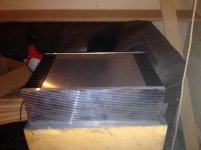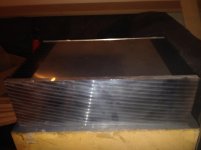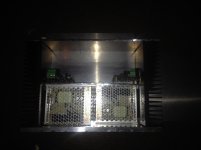Slight issue there is that the boards are slightly slanted so that the mountings are in the gaps between fins (when the little hex spacers are used). Broken too many M3 taps recently...
Bummer. For M3x0.5 mm threads I recommend drilling to 2.5 mm and using aluminum cutting fluid (I like A-9) and a good tap (spiral flute, TiN coated is nice) for cutting the threads. A tapping block or tapping guide is worth its weight in gold too.
Tom
Very nice.
Great job! Are those heat sinks on the LM3886 a stock item?
BTW, I have never flipped a board. Guess it keeps the wiring symetetrical.
Bit of a blast from the past, but I have picked up and remade a Parallel-86 amp. The original was in a slightly silly case with RCA inputs, this has been remade with XLRs as my World Designs Pre 3 has the option of wiring the outputs as balanced. As an aside from this, mini XLRs are horrible to use...

The case is a 3U/400 and each channel has a 300VA transformer and a Ringnot board, as with heatsinks and PSUs nothing exceeds like excess.
I have also added an soft start board, with the switch at the back as I have a toddler.
Great job! Are those heat sinks on the LM3886 a stock item?
BTW, I have never flipped a board. Guess it keeps the wiring symetetrical.
hi tom i to was thinking about wires being symmetrical and so am planning to mount my boards vertically also in a effort to save space is their any merit or pitfalls to this approach
Great job! Are those heat sinks on the LM3886 a stock item?
It's a ModuShop Dissipante chassis. 400 mm depth. The heat sinks come with the chassis.
hi tom i to was thinking about wires being symmetrical and so am planning to mount my boards vertically also in a effort to save space is their any merit or pitfalls to this approach
There's no advantage (or drawback) of having the wiring symmetrical. Feel free to geek out on the symmetry ... or not.
Tom
ps congrats on degree in psychology how you managed to achieve that as well as run business,create new designs and answer all our question is making me tired just thing about it
and what about mounting amp vertically
The only potential issue I see there is that the LM3886 might get up too high on the heat sink with one of the boards. I generally aim to place power devices about 1/3 up the height of the heat sink for the best thermal dissipation.
ps congrats on degree in psychology how you managed to achieve that as well as run business,create new designs and answer all our question is making me tired just thing about it
It's made me tired at times too. That's for sure! 🙂 It's been an enormously fun ride, though. Going back to school has been the break and change of scenery I needed. Now I'm ready to push on Neurochrome full time. Just have to wait until April when my last exam is done.
Tom
The clips came with the original amp, I kept them to keep some consistent clamping pressure on the LM4780s given I used U021041-15-U1 | Thermal Interface Sheet, Ceramic Filled Silicone Rubber, 1.2W/m·K, 101.6 x 101.6mm 2.03mm, Self-Adhesive | RS Components as the insulator.
The layout was really meant to try and keep the wiring logical and, as a result, as short as practical. One of those things that I always think is good practice even if it isn't always necessary.
The layout was really meant to try and keep the wiring logical and, as a result, as short as practical. One of those things that I always think is good practice even if it isn't always necessary.
yes i was thinking that to so went for the 04kw heats sinks so i at least have room to maneuver also im thinking Belden 19364 inside the amp would it be wise to implement the drain cable or leave it unconnected?or is this not recommended for internal power hook up cable?
as usual im trying to use what i have lying around 🙂🙂🙂
as usual im trying to use what i have lying around 🙂🙂🙂
Last edited:
I'd connect the drain wire of the power cable to the ground/PE terminal on the mains inlet.
Tom
Tom
am i sat watching trailer park boys twiddling my thumbs i have all need to complete my mod 86 including the badly scratched aluminum im now waiting to be replaced so no final build until mid next week im gutted all i can do is build mock ups sorry for bad pics[/ATTACH][/ATTACH][/ATTACH][/ATTACH]
Attachments
Last edited:
Dang! It looks like the front was cut from a piece of (very large!) bar stock. A couple of finishing passes with a fly cutter and some belt sanding should fix that right up.
Tom
Tom
yep thats 12ml eco cast very flat minimal tooling needed or should i say less ware shame the 5083 for the body was left too loose in package and the sharp edges left some very deep cuts on the eco cast also heat sinks had to be sent back for being chipped this has just been one of them builds
and yes i cant wait to sand and buff this baby
and yes i cant wait to sand and buff this baby
Last edited:
For those using the Modushop/diyAudio Store chassis (e.g. Mini Dissipante) with the baseplate: do you know how tall the baseplate is? I.e., how much height does the baseplate add to the bottom of the chassis? Maybe stated another way: how much internal height does the baseplate remove? I am designing the rear panel cutouts, and want to make sure I don't go too low and end up interfering with the baseplate.
FYI, I emailed diyAudio Store with this question, and received the following reply:
The inner useful height of the chassis is reduced by about 6-7mm once the base is mounted.
I was fortunate enough to hear a pair of bridged parallel monoblock m86 with the obsolete lm4780. They were powering some £75k speakers from an equally costly front end.
Stunning is a word.
Are the newer versions of the chip such as 3886 comparable?
Regards
James
Stunning is a word.
Are the newer versions of the chip such as 3886 comparable?
Regards
James
You can replicate a bridged Parallel-86 amp using two Modulus-286 modules. The Modulus-286 is a much improved version of the Parallel-86 using two LM3886es instead of the LM4780 (as the '4780 has been discontinued).
A more cost-effective way of accomplishing a bridge/parallel Modulus amp would be to use my Modulus-686. It uses two sections of three LM3886es in parallel with the two amp halves bridged for a bridge/parallel amp. Power it with ±27 V for a reasonable 130 W (8 Ω), 200 W (4 Ω) or max it out at ±36 V for 240 W (8 Ω), 360 W (4 Ω).
Tom
A more cost-effective way of accomplishing a bridge/parallel Modulus amp would be to use my Modulus-686. It uses two sections of three LM3886es in parallel with the two amp halves bridged for a bridge/parallel amp. Power it with ±27 V for a reasonable 130 W (8 Ω), 200 W (4 Ω) or max it out at ±36 V for 240 W (8 Ω), 360 W (4 Ω).
Tom
Hey, they were mine.
Tom, when you say much improved, in what way do you mean, other than using available parts and able to be purchased, better sounding?
Tom, when you say much improved, in what way do you mean, other than using available parts and able to be purchased, better sounding?
Last edited by a moderator:
Ah Simon I assume?!
Nice amps! I had to do a bit of sleuthing but as some of the images aren't showing I couldn't be certain.
They certainly sounded excellent and weren't at all out of place with the mega buck's system. In fact it sounded at its best with them, albeit we had to leave earlier so didn't get to hear anything afterwards.
Currently building up a class d based but hearing yours has got me thinking!
Nice amps! I had to do a bit of sleuthing but as some of the images aren't showing I couldn't be certain.
They certainly sounded excellent and weren't at all out of place with the mega buck's system. In fact it sounded at its best with them, albeit we had to leave earlier so didn't get to hear anything afterwards.
Currently building up a class d based but hearing yours has got me thinking!
Last edited:
Tom, when you say much improved, in what way do you mean, other than using available parts and able to be purchased, better sounding?
Much lower noise floor, thus, lower THD+N. For the Modulus-686, also lower THD (AFAIR).
I have found that the Modulus-686 sounds better than the Modulus-86, at least on my mid-efficiency LXmini speakers. I can't quite tell if the Modulus-686 sounds better than the Modulus-286 Rev. 2.0 in that application. I suspect it's my imagination, but it might not be.
Since your bridged Parallel-86 is more-or-less a Modulus-686 with two LM3886es pulled, I would expect it to share quite a few characteristics with the Modulus-686. That said, the Modulus-686 takes it a step further by using the two amp halves as a the power stage in a differential amp, so it's a rather different animal than a bridged pair of Parallel-86. You might get better imaging and overall sound quality with the Modulus-686 due to its architecture, lower noise floor, and improved THD. That's my hand-wavy guess. I have never measured a bridged Parallel-86 amp, so I can't elaborate more on the differences, unfortunately.
Tom
Last edited:
- Home
- Amplifiers
- Chip Amps
- Modulus-86 build thread



